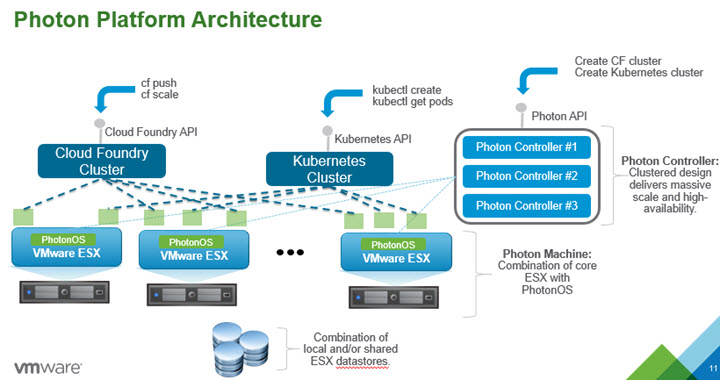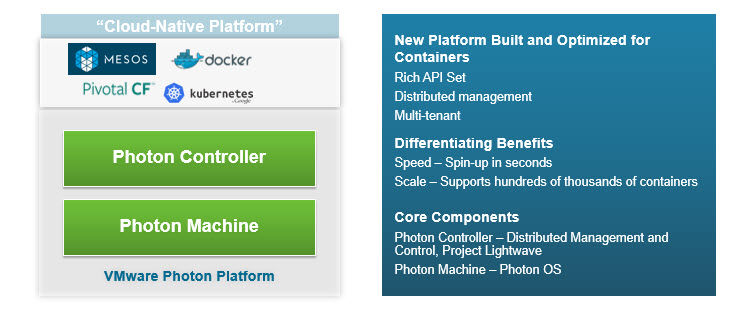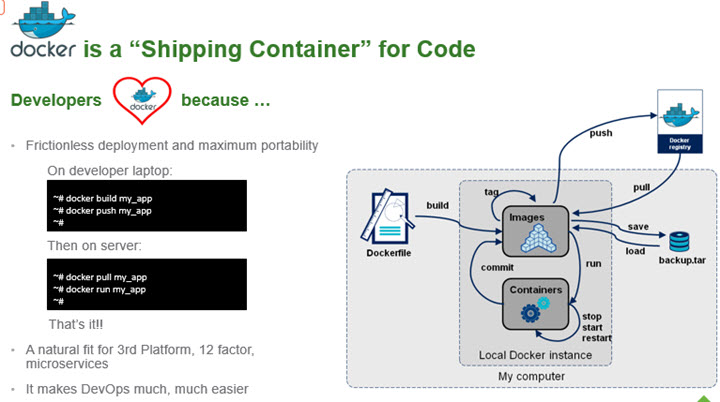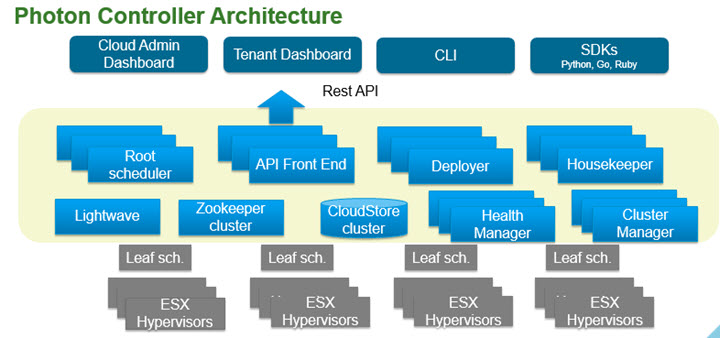VMware Photon platform and Photon controller are part of a new technology coming from VMware. I have already tested the PhotonOS VM installation in the lab, but this is just one part of the puzzle. The other parts are the Photon Controller, which is going to be Open Source, and the Photon Machine (a stripped down version of ESXi hypervisor).
By building the Photon platform VMware will allows to scale application dynamically and On demand. It's all API driven. The apps like that are called Cloud Native apps. For cloud native apps VMware is preparing an optimized, streamlined platform – VMware Photon Platform.
What's in the VMware Photon Platform?
It's an optimized platform for running containers, which uses API automation on large scale. Photon platform runs on stripped down ESXi hypervisor with container runtime environment based on Photon OS.

So Photon under the covers creates the different nodes, configures them, and then returns a Cloud Foundry API Endpoint, so developers can use it as any other part of the infrastructure. The heavy lifting under the hood is completely hidden (abstracted) and managed by the Photon controller.
Photon OS – Linux distro optimized for containers running within the optimized ESXi (Photon Machine).
Photon Machine – A stripped down ESXi hypervisor (without HA, vMotion and other un-needed services….).
The whole Photon Platform architecture looks like this:
The Architecture overview….
What's the buzz about containers …?
Containers are able to package and run your apps, which are highly portable. The simplicity to deploy a containerized application seduced many developers as all the dependencies are delivered with the app within the container. The application lifecycle is simplified.
As developper develops the application on their laptop for example, he (she) can deploy (push) the app into the production server. Then on the server, the admin can do a “pull” of that app in order to put it in production…
Here is a simple schema…
Photon controller architecture (is fairly complicated) can be found on the image bellow…
The Photon controller has a cloud admin dashboard (web based) and tenant dashboard. Managed by Zookeeper. ZooKeeper is a Distributed Coordination Service for Distributed Applications. ZooKeeper allows distributed processes to coordinate with each other through a shared hierarchical namespace which is organized similarly to a standard file system.
Plus, there is many more different other components which are part of the Photon controller.
From the announce:
The new infrastructure stack optimized for containers and cloud-native apps. It’s built to be used in API-driven, multi-tenant, high scale, greenfield environments. It’s composed of two main components: Photon Machine, a lightweight “microvisor” based on ESX with Photon OS built-in, and Photon Controller, a distributed high-scale control plane that includes Project Lightwave.
Get Photon Controller and test it yourself!
- Getting Started Guide: www.vmware.com/go/pcguide (unfortunately the download link for the OVA from the PDF does not work. Use this link instead:
- Blog: blogs.vmware.com/cloudnative
- Github: https://vmware.github.io/
- Twitter: @cloudnativeapps
- Google Group
Check VMware blog about Photon Controller Deep-Dive here.
Wrap-Up
As an enterprise virtualization admins has to collaborate with developpers, new containers technologies, to put into production new cloud applications faster, the Photon platform seems to be the a very good “tool” to use. However one question arise. To me this is quite specific environment which does not fit to everyone. I mean not everyone as an admin has do deal with bunch of developpers which kicking up containerized apps..
So as a result, this platform is “tailored” (or will be tailored) for worlkloads which are rather very specific. I do not see a small business or very small business using this technology in their environments. But who knows. We might see a further transormation in the enterprises and perhaps also an SMB sector will finally leverage containers at the end, for their environments. At least for dev environments…
For now I think the most important thing is to “consolidate” vSphere 6 and have it “bug-free”… Which curently is not the case…Check this KB – Backups with Changed Block Tracking can return incorrect changed sectors in ESXi 6.0





Dear Mr Vladan,
My name is fahad alajlan am certified VMware VCP5 Data center bat the validity of certification expired. Today I am pass exam 1v0-601 VMware certified associate 6 data center and 2v0-620 VMware vsphere 6 Foundations is there away to get VMware VCP6 Data center.
Best regards.
Fahad alajlan
You better check with someone from VMware Education. I’m not working for VMware.. T